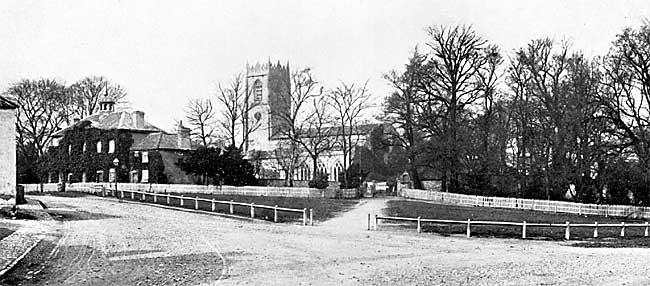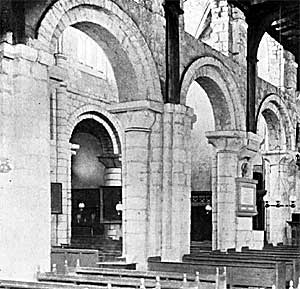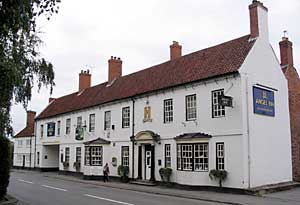The departed glories of Blyth

Blyth church and rectory, c.1901.
THE chequered history of Blyth is full of interest. In the village itself was established the earliest Notts, monastery; it is said to have had a castle as ancient as that at Nottingham and older than that at Newark. For a while it was the caput or chief seat of the de Busli's and it gave its name to the "Honour" or extensive territory held by that family. Within its parochial bounds, at Styrrup, was. one of the five places in England licensed for tournaments, and in Whitewater it possessed the only, natural lake in the county.
Mediaeval Blyth had two leper hospitals; here were no less than three hermitages; two important highways intersecting the village bore considerable traffic to which Tickhill Castle, four miles away, materially added in times of peace and war. It had markets and fairs and, according to a notable local historian (William Stevenson), it was one of the largest-towns in the shire.
Departed glories.
But its glories have largely departed. Of the priory only a glorious part of the church and a few ruins remain above ground. Of the castle no trace exists, and its existence is doubtful, although the Rev. J. Raine, the eminent historian of Blyth, thought such a structure possible. Tournaments and lazar-houses are things of the past. Railroads have by-passed the place; it is no longer a market town and its fairs are decayed. Now it is a large and handsome village with a dignified air of olden time.
Its history goes far back. It has yielded Bronze Age relics, far older than the Christian era, and skulls found in 1892 attest the presence of Early Man. Vestiges of Ancient Britons are found in two tumuli (sepulchral mounds). The old road from Ollerton may or may not have been Roman, but that which comes from Rempstone is believed to be of Roman date. Coins of that time have been found here, and in 1939 Mr. Adrian Oswald suggested that a mysterious earthwork was part of a boundary made in the twilight of Roman rule, and compared it with Offa's Dyke and Others.
The village occupies somewhat elevated ground which in olden days was surrounded by marshy and infertile land. Its population was small, but there was a Saxon church (not mentioned in Domesday) which was given to the priory at its foundation in 1088. Danish invaders marched along the Blyth road in 867 to capture Nottingham and subdue Mercia, but it was not until the Norman Conquest that Blyth attained eminence. It was included among the 174 manors in Notts, alone granted by the Conqueror to Roger de Busli, who is said to have built the castle here.
This may have been a timber fortress, as were others of that period, but in any event Roger soon erected for himself a much more formidable fortress at Tickhill, and when he founded the Benedictine priory he bestowed upon it the whole of Blyth with a market and fair and full manorial rights.
The Norman church.

Norman arcade in Blyth church.
The priory site is marked by the noble Norman church which is one of the architectural glories of the county, although shorn of its 60ft. chancel and otherwise mutilated. The monastery lay on the north side, separated from the church by the cloisters and garth or open area, and the hall covers the site of some of the domestic monastic buildings. As a daughter house of St. Katharine's (Trinity) at Rouen, its priors were long appointed by that house and many of the monks were Frenchmen, sent hither, it was reputed, by way of punishment. They fared ill from cold and wet, and an Archbishop suggested that five years should therefore be the limit of their stay. Under lax rule they were troublesome, and the prior at Rouen was invited to send no more unless they were more orderly. It has been suggested that the priory was established with a view of its brethren ministering to those wounded in the jousts and performing the last rites to such as died, but this is open to question inasmuch as it was not until more than a century after its foundation that the tournament field was licensed. It is possible, however, that as Norman knights were fond of jousting there may have been knightly contests here in de Busli's lifetime.
By 1098 Roger de Busli was dead and the infamous Robert de Belesme induced Rufus to make a grant to him of "the great fief of Blyth." In 1100 he supported Duke Robert against Henry I, and that king sent the Bishop of Lincoln with an army which reduced Tickhill Castle to submission. In 1194 history nearly repeated itself when the adherents of Prince John held out there against Richard I; it was their last remaining stronghold, but when Coeur de Lion captured Nottingham Castle and sent the Bishop of Durham to crush them the garrison surrendered. Upon these occasions Blyth must have been the royal base, deeply involved in the military operations.
Link with a Becket.
Henry I and Henry II both visited Blyth, doubtless staying at the priory, and when the Busli line became extinct the latter monarch bestowed the Honour of Blyth upon Ranulph, Earl of Chester, who is said to have died poisoned by the last of the Peverels. The second Henry confirmed its charters to the priory during his visit; one of the witnesses to the deed was Thomas a Becket, and another was Relph de Broc in whose castle at Saltwood the murder of that archbishop was planned. In 1216 William de Cressy, lord of Hodsock, founded the leper hospital of St. John; in 1446 it was rebuilt as a lodging for strangers and women in labour. The second hospital (St. Edmund's) was built near the north gate in 1228, and was entirely dependent upon casual alms, its agents being officially licensed to beg for its maintenance.
The Norman Conquest had so adversely affected Blyth that within 20 years its taxable value had declined by two-thirds, from 30s. to 10s., but the foundation of the priory, the tournaments, its market and fair, and the increase of population and commerce all tended to its Prosperity, and under the Plantagenets it greatly flourished. Agriculture and wool were its industries; there was considerable traffic on its roads, and travellers so often sought shelter at the priory that is obtained compensating relief from taxation. Kings and archbishops were constant visitors. In 1244 Henry III, when about to sojourn at Hodsock and Blyth, ordered the sheriff to select 26 tuns of wine at Boston for Nottingham Castle, and also to forward six tuns each to Clipstone and Blyth, and similar injunctions were issued at other times.
In 1256. that king held a "parliament" here, an event pobably associated with the action of the constable of Tickhill Castle who, during the Baronial War, raided Blyth with an armed force. There were other troubles too. The priory had the right to hang on the gallows at Emmeslowe (now Blyth Law Hill) robbers arrested within the liberty of Blyth, but when the bailiffs seized a cutpurse in the market he was forcibly seized by the Tickhill steward who conveyed him to the castle, and 5s. being refused by the prior for his surrender the man was immediately hanged. The prior was not so careful of the rights of others, for two years later, in 1274, he was found to have made a dyke which for four years past had rendered the highway impassable after heavy rain. About that time Ingeram de Oldcotes gave his manor there with property at Blyth to Roger Darcy, who undertook to obtain a knighthood for him and to provide maintenance and clothing for him and three men-servants for life. In 1300 John, son of Roger Darcy, was outlawed and his possessions were seized by the Crown which restored them to Constance de Byerne, his overlord, after a year and a day.
Growth of trade.

Angel Inn, Blyth (photo: A Nicholson, 2005)
By this time there were 15 merchants here, including a goldsmith, who would also be the local banker. The Angel Inn had been long established—it is claimed as the oldest in the shire—and in 1274 its bill for the night's entertainment of the Bishop of Durham and his retinue came to 89s. 71/2d. (probably £75 in modern currency), of which 33s. 5d. was for wine. Under the first three Edwards Blyth was a point of assembly of troops for the Scottish campaigns, and the locality was being ravaged by extortionate royal purveyors who seized horses, carts, and goods, sometimes fraudulently, for which they received punishment. In 1278. the priory was partially destroyed by fire, and the king of his charity made grants of "oaks fit for timber" from Sherwood Forest towards its repair.
